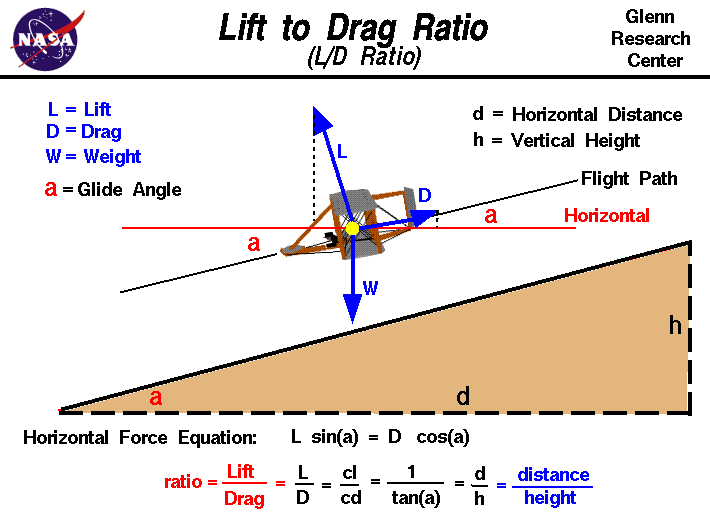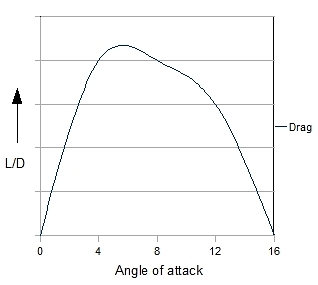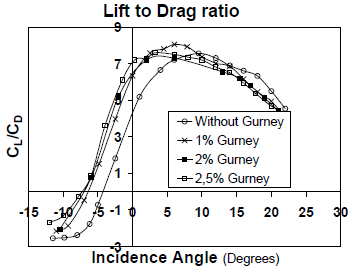Lift-to-drag ratio
Glide ratio ε, γ glide angle and slip ratio e are aerodynamic characteristics of an aircraft in steady gliding flight.
Definition
- The glide angle γ is the angle at which an aircraft slides in drive-free state ( glide ) from the horizontal downwards. This is a characteristic value of the airfoil.
- The tangent of this angle of approach is the glide ratio ε.
- The slip ratio e is the reciprocal value of the glide ratio. The glide ratio indicates how many meters slides a plane in still air in a horizontal / horizontal direction while it loses one meter altitude.
The terms glide ratio and glide ratio can also be used in reverse, against each other exchanged senses.
- In gliding, the maximum glide ratio of an airplane and the indication of the corresponding airspeeds to describe the flight performance is used together with the least decline (in m / s).
- As a glide path are referred to in landing approaches under instrument flight rules actually flown from the landing descent profile brand to touchdown on the runway. When an aircraft is on final approach, the co-pilot or an automatic voice of the EGPWS counts the distance to the ground ( in feet ) down immediately prior to installation of the machine.
Mathematical Description
For stationary glide (constant aircraft mass, constant speed ) applies:
Dividing results from the above equations:
Because the angle of repose of the path angle is relative to the horizontal and the glide path along G, the flying height H is measured perpendicular to it, shall apply
The Sinkweg S is then the hypotenuse of the right triangle:
For one, this must be noted that the aircraft 's altitude above the air pressure measures, so that the error of the barometric height measurement must be considered. Furthermore, the true height can be clearly distinguished above the ground, depending on the terrain of the barometric altitude. It must also be noted that the data are generally based on aerodynamic characteristics on the still air. In the presence of wind but differs ground speed of the airspeed.
Examples
- With a glide ratio of about 2.86 ° glide ratio is 0.05 (or 5 % ) for the slip ratio of E = 20
- A glide ratio of 0.02 ( glide ratio 1:50 ) corresponds to a glide ratio of about 1.15 °.
- With a glide ratio of 1:20, an airplane shall, in the loss of 1,000 meters above sea level, a distance of 20 km back, 1:50, equivalent to 50 km.
- The nowadays flown in competitions gliders ( standard class ) have a glide ratio of 1:42 to 1:52 at a speed of 110 km / h Have used in the training ( inexpensive) gliders sliding conditions of 1:25 at about 85 km / h ( wood - steel tube ) to about 1:38 at 100 km / h ( plastic). The Glider ETA ( derived from the Greek symbol for efficiency) it brings the glide ratio even on a peak of 1:70.
- An airliner ( eg Airbus A340 ) brings it to a glide ratio of about 1:16 at a speed of around 390 km / h
Maximum glide ratio
A plane has no constant glide ratio, it depends on the speed and gustiness of the ambient air, as well as from the control art of the pilot. A pilot flies his glider in flight condition, not pushed, he can get very close to the theoretical glide ratio. Unclean ( -shifting ) fly reduces the glide ratio.
The glide ratio is not affected by the mass of the aircraft. In the state best glide rises with increasing weight but the airspeed. However, a heavy aircraft rises slowly on the rise, as the sink rate is larger and because of the higher required rate even when the curve radius circles is greater. This is disadvantageous because updrafts are stronger toward mostly to the center. High-performance gliders are therefore possible light built, but equipped with water tanks. Good thermals, the pilot can make his plane by water ballast harder and faster. If the thermals go bad, it can restore the original light condition by draining the water. Also, the landing, the water is usually drained to fly slower can.
Generally when sliding that the energy required to overcome the air resistance due to lack of engine comes solely from the loss of height - the propulsion represents a component of the weight force dar. Furthermore, the speed can be regulated only on the angle of attack of the wing. As can be seen in the polars of an airfoil profile, the ratio of lift to drag at various angles of attack changes.
The maximum drag ratio is not at the lowest speed of the sinking or best achieved, since there is the resistance also becomes large. So it must be applied to a given distance more height in order to maintain the speed.
Nor is an advantage of the approach at the slightest resistance, because there the lift is low. The maximum glide in between and can be read from a graph of the performance polars. This best glide speed is a compromise between the highest possible lift at the same time the lowest possible resistance.
Increasing the mass of the aircraft, more energy can be recovered from the same height loss, or it is necessary less height loss for holding a certain speed.
Here, the performance of polar shifts, and best glide ratio is achieved at a higher speed.
Glide ratios in gliding
In gliding long distances are often flown, for the sake of flight safety and because there are no thermals at night, only during the day can be flown and the track is thus limited by the average speed. Therefore, not only the speed of minimum sink of importance, which ensures a quick gain of height in thermals, but rather the speed of best glide.
A higher maximum glide ratio allows it to build a longer gliding distance to the next thermal zone. This leads to a higher average velocity.
Also, many performance gliders - for days with particularly good thermals - are loaded with water ballast. This makes it possible to move, which means that you can cover a distance faster with the same glide best glide ratio of a glider at higher speeds. However, the rate of climb, worsen by the extra weight when circling in thermals. The advantage here are gliders with flaps, in which the circles in thermals - through positive flap position - a " slow flight profile" high lift coefficient can be selected. In a weakening of the thermal ballast water is discharged in flight. The best glide ratio of a glider is not altered by the water ballast.
To enable a steep landing approach, the glide ratio should be as low as possible. This is achieved in the approach by extensible landing aids that increase the aerodynamic drag of the aircraft and simultaneously destroy a part of the lift. Thus, a significantly higher rate of descent than in normal driving is achieved. Widely used are the air brakes ( Schempp- Hirth dive brakes, see figure), which are extended approximately in the middle of the airfoil section perpendicular to the air flow, and the glide ratio of 40 or more to the approach can be reduced to 5 to 10. As a supplement - especially in older wooden aircraft - the flight maneuvers sideslip ( Slip) effectively, in which brought the aircraft by pressing counter-rotating cross and rudder in an inclined position and the fuselage is turned transversely to the direction of flight.









